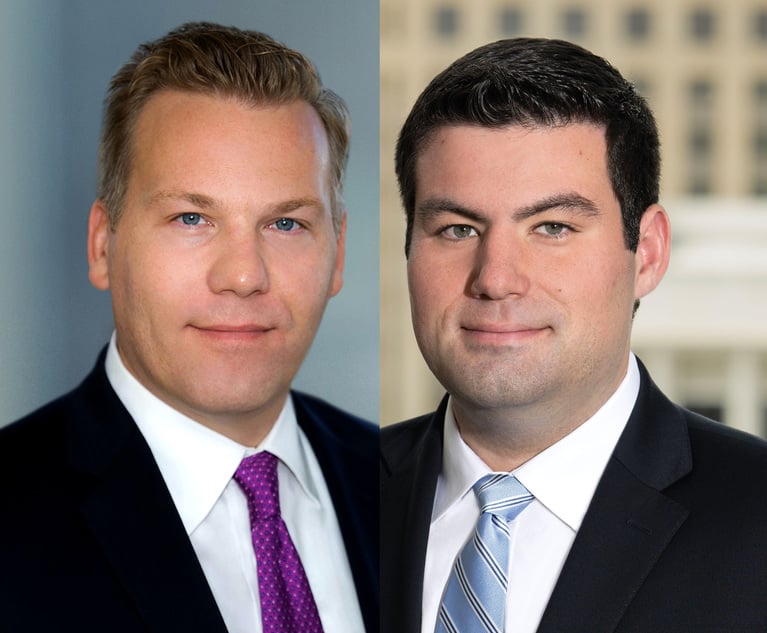Cause of Action for Professional Negligence Accrues at the Time of Injury, Not When Damages Occur
The Delaware Supreme Court held that for tort claims, such as legal malpractice claims, the wrongful act occurs at the time of injury, however slight, and the statute of limitations can start to run before any actual or substantial damages occur.
May 06, 2020 at 09:00 AM
7 minute read
 Barry M. Klayman and Mark E. Felger
Barry M. Klayman and Mark E. Felger
When does a cause of action for professional negligence accrue? In ISN Software v. Richards, Layton & Finger, No. 110, 2019 (Del. Feb. 17, 2020), reargument den. (March 30, 2020), the Delaware Supreme Court, sitting en banc, held that for tort claims, such as legal malpractice claims, the wrongful act occurs at the time of injury, however slight, and the statute of limitations can start to run before any actual or substantial damages occur.
As alleged in the complaint, ISN wanted to convert from a C corporation to an S corporation for tax purposes. However, four of its eight stockholders could not qualify as S corporation stockholders. ISN consulted its law firm, Richards, Layton & Finger (RLF), which advised that ISN could use a merger to cash out some or all of the four stockholders. The cashed-out stockholders could then accept ISN's cash-out offer or exercise appraisal rights under Delaware law. ISN did not proceed with the conversion, but decided to use a merger to cash out three of the four non-qualifying stockholders. ISN completed the merger and reserved funds for the buyout or appraisal award based on the cash-out offer price.
After ISN completed the merger, RLF notified ISN that its advice might not have been correct, and that all four stockholders, including the stockholder whom ISN wanted to exclude from the offer, were entitled to appraisal rights. ISN decided to proceed with the merger and RLF agreed to litigate any appraisal action. RLF and ISN signed a conflict consent agreement, which recited that the proposed representation posed a "potential conflict," since litigating issues arising from the firm's prior legal work may generate a conflict of interest when there is a plausible claim that the firm's prior work was deficient. The agreement further provided that ISN's consent to RLF's representation did not constitute a waiver or release of ISN's potential claims, "if any," against the firm. ISN retained independent counsel to advise it whether to enter into the consent agreement; however, ISN did not raise the possibility of a tolling agreement to preserve its legal malpractice claim.
Three of the four stockholders filed for appraisal, including the largest stockholder whom ISN had hoped to exclude. Over three years later, the Delaware Court of Chancery decided the appraisal action, resulting in a total appraisal value in excess of the amount reserved for the buyout.
ISN then filed an action for legal malpractice against RLF relating to its advice concerning the merger and appraisal rights. The complaint alleged that ISN had been damaged to the extent that the total appraisal value exceeded the reserve amount. RLF moved to dismiss the complaint on statute of limitations grounds. The Superior Court granted the motion. It found that ISN's cause of action accrued on the date that RLF informed it of the alleged negligent advice or, alternatively, when the appraisal action was filed, both of which occurred more than five years before ISN filed suit against RLF.
A majority of the Supreme Court, sitting en banc, affirmed the judgment of the Superior Court, although it applied a different analysis. As the majority viewed the case, the question to be decided was when did ISN suffer injury, however slight, as a result of the alleged faulty advice. The majority concluded that the injury occurred to ISN when the fourth stockholder—the largest of the group and the one whom ISN sought to exclude from the cash out—obtained the right to demand appraisal. Because of RLF's alleged faulty advice, ISN ended up allowing the fourth stockholder to demand appraisal, meaning that ISN could be liable to pay fair value for more shares than contemplated in the cash out transaction. Thus, ISN was liable to pay the fair value of more stock than it had planned, which injured ISN financially.
The majority expressly rejected ISN's argument that its cause of action did not accrue until it could state a claim, whether for injunctive relief or for damages, and damages were not certain until the Court of Chancery's appraisal decision exceeded its reserve amount. ISN argued that it suffered no damages at the time of the merger because the costs to litigate an appraisal proceeding were the same regardless of the number of shares involved, and if the total appraised value of the stock did not exceed the amount it had set aside to cover its expenses, it would not incur any damages. The majority said that ISN failed to distinguish between an injury sufficient for a cause of action to accrue and damages. Under the Delaware occurrence rule, injury is distinct from damages. The statute of limitations can begin to run before any actual or substantial damages occur. The unintended consequences of the merger injured ISN when the transaction closed because it could not proceed without new liabilities—providing greater appraisal rights than it had intended or unwinding the merger. Once injured, ISN could have brought its legal malpractice claim. As the majority opinion stressed, "Under the current state of Delaware law, however, regardless of complications, inefficiencies, and possible unfairness, a cause of action accrues at the time of the wrongful act, which in this case means when injury occurred and not when damages were certain."
In a rare dissenting opinion, Justice James Vaughn wrote that he would hold that the statute of limitations begins to run when the plaintiff sustains an injury for which the law affords a remedy. Specifically, he would have found that when damage is an essential element of a tort, the claim does not accrue at the time of the defendant's wrongful act or the plaintiff's discovery of the injury, but when the harm is sustained. However, it is not required that all the damages resulting from the act must have been sustained at that time, and the running of the statute of limitations is not postponed by the fact that the actual or substantial damages do not occur until a later date. Since the Superior Court never addressed the key issue—when did ISN sustain injury— Vaughn would have reversed and remanded the case for further proceedings, including proceedings to determine when ISN sustained an injury for which the law afforded a remedy.
Significantly, ISN's statute problem could have been avoided if at the time it agreed to the conflict consent agreement, which provided that ISN was not waiving but was preserving its malpractice claim, ISN had also insisted on a tolling agreement with RLF. If RLF had refused, ISN could have filed the malpractice action and sought to have the action stayed until the extent of the damages was certain. The fact that ISN had the advice of independent counsel when it decided to proceed with the merger and give appraisal rights to all four stockholders, and did not seek a tolling agreement with RLF, was not lost on the majority.
Barry M. Klayman is a member in the commercial litigation group and the bankruptcy, insolvency and restructuring practice group at Cozen O'Connor. He regularly appears in Chancery Court.
Mark E. Felger is co-chair of the bankruptcy, insolvency and restructuring practice group at the firm.
This content has been archived. It is available through our partners, LexisNexis® and Bloomberg Law.
To view this content, please continue to their sites.
Not a Lexis Subscriber?
Subscribe Now
Not a Bloomberg Law Subscriber?
Subscribe Now
NOT FOR REPRINT
© 2025 ALM Global, LLC, All Rights Reserved. Request academic re-use from www.copyright.com. All other uses, submit a request to [email protected]. For more information visit Asset & Logo Licensing.
You Might Like
View All
Chancery: Common Stock Worthless in 'Jacobson v. Akademos' and Transaction Was Entirely Fair
5 minute read
The Importance of Contractual Language in Analyzing Post-Closing Earnout Disputes
6 minute read
Delaware Supreme Court Upholds Court of Chancery’s Refusal to Blue Pencil an Unreasonable Covenant Not to Compete
4 minute readLaw Firms Mentioned
Trending Stories
- 1Uber Files RICO Suit Against Plaintiff-Side Firms Alleging Fraudulent Injury Claims
- 2The Law Firm Disrupted: Scrutinizing the Elephant More Than the Mouse
- 3Inherent Diminished Value Damages Unavailable to 3rd-Party Claimants, Court Says
- 4Pa. Defense Firm Sued by Client Over Ex-Eagles Player's $43.5M Med Mal Win
- 5Losses Mount at Morris Manning, but Departing Ex-Chair Stays Bullish About His Old Firm's Future
Who Got The Work
J. Brugh Lower of Gibbons has entered an appearance for industrial equipment supplier Devco Corporation in a pending trademark infringement lawsuit. The suit, accusing the defendant of selling knock-off Graco products, was filed Dec. 18 in New Jersey District Court by Rivkin Radler on behalf of Graco Inc. and Graco Minnesota. The case, assigned to U.S. District Judge Zahid N. Quraishi, is 3:24-cv-11294, Graco Inc. et al v. Devco Corporation.
Who Got The Work
Rebecca Maller-Stein and Kent A. Yalowitz of Arnold & Porter Kaye Scholer have entered their appearances for Hanaco Venture Capital and its executives, Lior Prosor and David Frankel, in a pending securities lawsuit. The action, filed on Dec. 24 in New York Southern District Court by Zell, Aron & Co. on behalf of Goldeneye Advisors, accuses the defendants of negligently and fraudulently managing the plaintiff's $1 million investment. The case, assigned to U.S. District Judge Vernon S. Broderick, is 1:24-cv-09918, Goldeneye Advisors, LLC v. Hanaco Venture Capital, Ltd. et al.
Who Got The Work
Attorneys from A&O Shearman has stepped in as defense counsel for Toronto-Dominion Bank and other defendants in a pending securities class action. The suit, filed Dec. 11 in New York Southern District Court by Bleichmar Fonti & Auld, accuses the defendants of concealing the bank's 'pervasive' deficiencies in regards to its compliance with the Bank Secrecy Act and the quality of its anti-money laundering controls. The case, assigned to U.S. District Judge Arun Subramanian, is 1:24-cv-09445, Gonzalez v. The Toronto-Dominion Bank et al.
Who Got The Work
Crown Castle International, a Pennsylvania company providing shared communications infrastructure, has turned to Luke D. Wolf of Gordon Rees Scully Mansukhani to fend off a pending breach-of-contract lawsuit. The court action, filed Nov. 25 in Michigan Eastern District Court by Hooper Hathaway PC on behalf of The Town Residences LLC, accuses Crown Castle of failing to transfer approximately $30,000 in utility payments from T-Mobile in breach of a roof-top lease and assignment agreement. The case, assigned to U.S. District Judge Susan K. Declercq, is 2:24-cv-13131, The Town Residences LLC v. T-Mobile US, Inc. et al.
Who Got The Work
Wilfred P. Coronato and Daniel M. Schwartz of McCarter & English have stepped in as defense counsel to Electrolux Home Products Inc. in a pending product liability lawsuit. The court action, filed Nov. 26 in New York Eastern District Court by Poulos Lopiccolo PC and Nagel Rice LLP on behalf of David Stern, alleges that the defendant's refrigerators’ drawers and shelving repeatedly break and fall apart within months after purchase. The case, assigned to U.S. District Judge Joan M. Azrack, is 2:24-cv-08204, Stern v. Electrolux Home Products, Inc.
Featured Firms
Law Offices of Gary Martin Hays & Associates, P.C.
(470) 294-1674
Law Offices of Mark E. Salomone
(857) 444-6468
Smith & Hassler
(713) 739-1250







